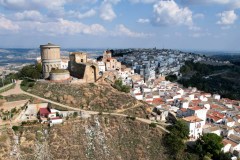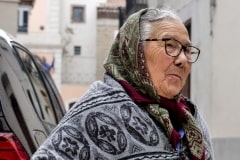Page Contents
For a lot of European travellers (myself included), planning a Southern Italy road is an excellent idea, since this part of the country is relatively unexplored.
In fact, it seems to be more popular to travel in the north and it’s better connected and has some of the major cities. But please don’t let that stop you venturing into the south!
Yes, you’ll need a car. Yes, it’s off the beaten track. And yes, many people won’t speak English. But that’s exactly the reason you should go. This kind of travel is rugged and authentic, something not easily found in Europe. Basilicata is also the second least visited of the 21 regions of Italy.
These are exactly the reasons you should go, which leads me on nicely to a few extra points below.
Is Basilicata Worth Visiting?
Absolutely. As one of the least travelled regions in Italy, Basilicata is very affordable. It has amazing history and stunning small Borghi.
Borghi: small towns or communities usually perched on the top of a mountain or vista, the singular also known as a Borgho.
In your road trip south Italy, make sure to include Matera, a UNESCO World Heritage Site, and as you’d expect in Italy some amazing food to enjoy, including ‘Lucanica di Picerno’, the pork sausage.
Where is Basilicata?
Basilicata is a region in the south of Italy, and one of the least visited. There are two coastlines in Basilicata, the Tyrrhenian Sea between Campania and Calabria and the Gulf of Taranto.
Short on time?
Here are the quick things you need to know for your trip to Italy
These are our reliable partners and services that I recommend and personally use on my trips.
➡️ Search for the best Tours on Viator & GetYourGuide
➡️ Look at luxury or affordable hotels on Booking or Expedia
➡️ Options for Car rental
➡️ The best travel insurance for Italy
➡️ Check the flight prices from the UK or the USA
➡️ Make sure you have your e-SIM!
Each offers unique value and special deals tailored just for you. Don’t miss out on these when travelling to Italy!
How to Get to Southern Italy?
Getting to Basilicata is easiest from the city of Naples and its international airport. There are plenty of places at the airport to hire a car and you will need one for travelling around Basilicata. I don’t recommend spending much time in Naples.
Our trip was to focus on the previously mentioned Borghi, effectively linking 9 hidden gems into one road trip. Many of these you won’t have heard of, and as you see the photos and read my words you’ll wonder why. As did I.
Why aren’t these places better travelled? Why aren’t they going viral on Instagram? Well let’s try to change that.
Best Tours in Southern Italy
If you don’t plan, or can’t drive in Italy, then the best way to discover South Italy is to sign up for a tour. But there are several trip to join and it can be confusing to understand which one is the best.
Let me make is easier for you – These are the 3 best tours to consider when in Southern Italy.
Day Trip in Basilicata
The best way to visit Basilicata is to sign up for this tour, which leaves from different places, including Rome, Matera, or even Potenza.
This tour will cover many hidden gems around Basilicata with an excellent service from the driver and tour guide, and you can offer the South Italy road trip itinerary in this guide.
Check out the tour here below!
8 Days Best of Puglia and Basilicata
A more comprehensive and longer trip is this full tour of Puglia and Basilicata, and they hand-picked some of the most stunning locations in Southern Italy for a cultural and relaxing adventure.
The tour start in Bari, where you’ll be taken to your luxurious 4-star village before embarking on your exploration.
Over the next 8 days, you’ll be taken on a private tour to breathtaking places such as Alberobello, Locorotondo, Matera Sassi, Metaponto, Policoro, Craco, Aliano, and Pollino.
The guide will accompany you for a two-hour tour at each destination, providing you with insider stories and exciting facts about the history, culture and traditions of each area.
Maratea
Our next stop took us to the Basilicata Coast, still in Potenza and to the medieval town of Maratea. Maratea is known for a few things, firstly as “the Pearl of the Tyrrhenian” and the town with 44 churches!
Maratea is known as “the Pearl of the Tyrrhenian”
But I knew it for a different reason, I’d seen the incredible Italian version of Christ the Redeemer (Il Redentore) standing tall above the coastline, and what a site that was. We arrived as the sun was setting, so the statue was to be our first stop.
It’s a 22-metre-high statue opposite the Basilica of San Biagio, it’s an astonishing structure. We drove there as the light was fading, but in truth I wish we had hiked there first thing in the morning. Either way this simply a must see in Maratea, and in Southern Italy in general.
Maratea has a thriving harbour featuring a few upmarket bars and shops, or you could get lost in the cobbled streets of the old town. But it’s really known for its hiking and cycling. You are spoiled for choice on the Tyrrhenian coast, with countless mountains and hidden beaches. Or why not cycle up to Il Redentore? You’ll certainly earn that view.
Hot Tip: On the drive to Maratea take the SS585 and stop at the viewpoint overlooking the stunning town of Rivello.
Best Tour in Maratea
Do you have little time to see Maratea and want to make the most of it? The answer is joining this private tour which is both affordable and comprehensive.
The tour guide will show you everything from the views from Mount San Biagio to the Basilica in town, as well as some local cafes and restaurants serving some of the best food you’ll ever try.
Of course, you’ll stop at the Christ the Redeemer statue, which is the second largest in the world, after the one in Rio de Janeiro.
I just can’t imagine a cooler tour to join!
Latronico
Our next Borgho in the province of Potenza is Latronico, one hour’s drive from Maratea. It’s firstly worth noting that this town will be a little cooler than the others, at an elevation of 888 metres.
Latronico is much quieter the previous two Borghi’s and has a smaller population. There are a few hiking spots in the area and close by you have the Pollino National Park and the highest peak of Serra Dolcedorme at 2267 metres.
You can drop by the Museo Del Termalismo art gallery or even the Terme Lucane Spa. Terme Lucane is well worth visiting for the local walking and stunning waterfalls, but personally the spa felt more like a medical centre.
Hot Tip: Two tips for food, local specialities at Taverna Nonna Vera or a friendly vibe and great pizza at Just Burger & Pizza, where we watched football with the locals!
Aliano
Moving onto the Province of Matera now and to the picture-perfect town of Aliano. This will take you just over one hour to reach from Latronico. It’s our smallest so far.
I’d seen this stunning Borgho a few times in my research into Basilicata. The stunning location of the town on a ridge overlooking the Calanchi region. It’s also known as the setting for Carlo Levi’s book ‘Christ Stopped at Eboli’.
Carlo Levi was a popular author, activist, painter, journalist, and doctor who was exiled to Aliano in 1935. There are statues and museums dedicated to his work, and even his final resting place.
As we arrived, we were greeted by colourful street art, Carlo Levi statue and amazing views. It has a great vibe to it, and most of the locals were extremely welcoming.
Just a handful of places were open (we were travelling in October, a shoulder season). The evening was interesting, with only one restaurant opening at 8pm and serving a €25 16-course set menu. No chance to choose, no translation, no vegetarian option (I like to be meet-free if I can), but wine included. We decided to get stuck in, not that we had much choice.
We were eating at Taverna La Contadina Sisina, which we later discovered is well-known favourite locally. During the meal, we researched the restaurant. Sisina started serving food to local poor people, using only locally sourced and cheap produce, she later started a restaurant with her popular recipes.
Supporting places like this is what travelling in off-the-beaten track locations is all about, and I highly recommend you visit. Unless you’re vegetarian!
Hot Tip: Visit the Calanchi, known as the Badlands. In any other area this would be full of tourists, but the unique landscape of the Calanchi is almost unknown. We saw barely any tourists here. You can drive through it on the way to the next Borghi but allow plenty of time. This landscape must be seen to be believed.
Rabatana
“A place where time stands still”, said the owner of our guesthouse (detailed below). Rabatana overlooks the town of Tursi, which feels like an overcrowded bustling city compared with Rabatana. It’s not, that’s just to emphasise the peaceful existence of Rabatana.
We are still in the province of Matera, and Tursi is just 45 minutes from Aliano, but as I said above allow some time to see the Calanchi.
Rabatana has an incredible history, and dates back to the year 800. It was built by the Saracens, who ran the town for 400 years whilst others around them were defeated. It was probably due to the unique location of the Borghi.
You’ll notice Rabatana is a work in progress, much of the town needs restoration and TLC. But some places have been lovingly restored. We met Antonio, an owner of one of those restored guesthouses and restaurants; Palazzo dei Poeti. He talked of people escaping their busy lives to ‘breathe and open their minds’ here in Rabatana.
As I sipped my morning espresso from the view at the Manderine, Orangery Retreat I saw exactly what he meant.
Depending on when you visit, you may need to travel into Tursi for food. If so, I recommend a traditional pizza at Braceria da Diego. But please stay at the guesthouse below.
Rabatana is a true hidden gem, and one of my favourite Borghi’s so far.
Hot Tip: One of the most unique places I’ve ever stayed; The Manderine, Orangery Retreat. Lovingly restored by its owner Martina with charm and attention to detail, but without being too perfect. It’s rustic and romantic. But what about that balcony view? Unbelievable.
Pisticci
The final Borghi in the province of Matera, and just 40 minutes by car from Tursi is the Pisticci, the ‘white town of Basilicata’.
At first impression it felt busier than previous Borghi’s, and with a population of nearly 18,000 it’s one of the largest we would be visiting. It’s another town located on a stunning spot perched on top of three hills.
We headed to the old town and the Dirupo District, where you can walk the cobbled streets and get a view of the town. These views even stretch as far as the Ionian Sea.
You can walk up to highest and oldest point of Pisticci, Torrevecchia, a square tower that was once part of the Norman castle. It’s quite a sight and certainly stands out in my drone photography of the town. Amazing.
This region is still part of the clay formed Calanchi region, meaning there are more of the ‘badlands’ to explore, but also making it susceptible to landslides. This has been a challenging factor of this region’s history and the rebuilding of Pisticci.
Hot tip: throughout Basilicata try Amaro Lucano, an Italian liqueur or aperitif usually sipped after dinner. It has a medicinal feel, and certainly warms the insides! Pisticci is the production site of this famous liqueur.
Acerenza
Our next Borghi is around 1.5 hours from Pisticci, however it’s here you might chose to stop at Matera. No article about Basilicata would be complete without referencing Matera, it’s an incredible place, but we are focusing on the lesser-known Borghi’s in this trip.
Acerenza is another one of the smaller Borghi’s on the trip, in the province of Potenza. It’ another Borgho at a high elevation as 833 metres. The elevation combined with the nearby Lake Acerenza gives a unique fog that often engulfs the village, as when we first arrived. Driving though narrow streets not being able to see 5 metres in front of you was certainly a challenge!
Azerenza is nicknamed the Cathedral City, as the imposing towers dominate the view of the ancient town. The Cathedral of Saint Mary is the first place of interest here and a must visit in Acerenza. It’s a Roman Catholic cathedral with a unique crypt dating back to 1524.
The second place you must visit is the Museo Diocesano Acerenza. Featuring many ancient artifacts and treasures from the cathedral and Archbishops. It also features every Archbishop through time, and this kind of history really blows my mind!
Hot Tip: the village has very little phone signal or WiFi, so stop for a perfect Italian espresso at A'mmond Acerenza and their super-fast WiFi.
Venosa
It took us just under 1 hour to drive to Venosa, in the province of Potenza. It’s a town with fantastic history and archaeological importance.
Our first stop was the Venosa Aragonese Castle, where they explained that both the open-air archaeological park and archaeological museum below the castle were just €2.50 entry. Fantastic value.
After a look around the castle, we headed to Scavi Archeologici di Venosa, a breath-taking site with remains of the Latin colony of Venusia founded in 291 BC! Let that sink in. The fully restored Abbey of the Holy Trinity is quite a sight to behold, and the Benedictine Abbey dates back to the Norman Era.
We then headed to the museum which has recently been modernised. Sadly, the Jewish catacombs are not open to the public at this time.
We had pizza (yes, another one) at Il Brigante pizzeria trattoria, by Michele Leo. Michele has a fascinating story, and this pizzeria is one I can recommend.
Hot Tip: sleep at an Air Bnb that overlooks the castle called Il Belvedere Aragonese, or a historic B&B in Piazza Orazio. Both places were fantastic!
Best Tour in Venosa
You might not have enough time on your southern Italy itinerary for Venosa, and for this reason, joining a 2-hour walking tour is a no-brainer, and I couldn’t recommend it enough.
This tour is not just a stroll through history, but a journey that takes you through time to discover one of Italy’s best-kept secrets.
Begin your adventure at the Archaeological Park where you can witness the remainders of the ancient Roman Empire. Marvel at the thermal baths, the domus, and the SS.
After this, you’ll continue your journey to the historic center and marvel at the 16th-century Aragonese castle Pirro del Balzo. Explore the national archaeological museum and uncover the Roman finds that tell the story of Venosa’s past.
This tour is perfect for both history buffs and adventure seekers, and that’s why I highly recommend it!
Rionero in Vulture
Our final Borgho on this trip was Rionero in Vulture, located on the slopes of Monte Vulture and just a short 30-minute drive from Venosa.
It’s a town well-known for its mineral water and hiking. And in truth, we spent most of the day hiking to and from Rionero, instead of exploring the town itself.
We started our hike in the Belvedere Forest, with plans to head down to Lake Monticchio. We had some fantastic guides explaining about chestnut season and the importance of the forest in traditional medicines. Every step of the way spotting amazing views of Lake Monticchio.
Before reaching the bottom, we stopped at San Michele Abbey, a monastery and place of worship carved into the side of the mountain with spectacular views over the lake. This is a place that really must be seen to be believed.
The lake itself was a popular local hangout, especially being the weekend. It was great to see so many people enjoying Lake Monticchio.
Our final stop of the hike before lunch was the Archaeological Park of Sant’Ippolito. You must have permission from a local guide or historian, but it’s another fascinating example of the history on offer in the region of Basilicata.
Hot tip: re-energise yourself with some local food and wine at Agriturismo Villa Delle Rose restaurant. Basilicata wine, antipasti, local cheeses, pasta, and prosciutto. Perfect.
And just like that we finished a long day in the Borgho of Rionero, where we just had time to explore Palazzo Fortunato and review the trip for our video. If we had time, I would have also loved to visit the Bourbon Prison and Brigandage Museum, so add these to your itinerary.
I felt like we blended in with the locals in the Palazzo, drinking espresso and discussing the day. I am starting to enjoy this kind of lifestyle and will be back in Basilicata again very soon.
Conclusion
This article was written in partnership with the Italian Tourism Board and their Viaggio Italiano project. But as always, the photography used, and opinions are all my own. Thanks for reading and happy travels.





































